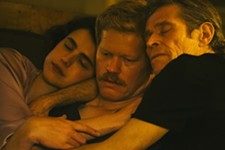Breaking Ground: What Three New Studios Mean for the Texas Film Industry
As construction begins, lawmakers seem eager to reform the state's incentives to fill those soundstages
By Richard Whittaker, Fri., March 17, 2023

The view from out front of Stray Vista Studios is pretty breathtaking. It's no wonder that studio founder and owner Nate Strayer picked this nondescript industrial park in Dripping Springs, looking right over the Hill Country (although, he confides, having a rum distillery as a neighbor doesn't hurt, either). "It's what I hear Burbank was like before Disney first opened his studio there," he said.
But it's the view inside that's really going to attract interest, the one created by the biggest Volume soundstage in Texas. The technology may be new to many, but they'll be familiar with the end results if they've watched The Mandalorian or any of a host of other films and TV shows shot on a Volume stage. Walls of LED screens create real-time environments, powered by the Unreal software engine. There's a real camera on the soundstage, and a virtual camera within the racks of servers behind the screens. In seconds, the location shifts from desert to jungle – modeling tools can create mountains instantaneously. The end result is simple: infinite location shooting, massively reduced turnaround for projects. "As soon as you're done shooting, you have your hard drive of your final footage." Strayer said. "You don't have to do months of VFX or motion tracking."
To prove his point, Strayer played a video on his phone: a commercial that had been shot on the stage only a week earlier and now was almost completely ready for broadcast. Strayer said, "If you have a 30-second spot, and you need to be in five different locations, you can spend five days shooting or have a bunch of company moves in one day, or you can come into a place like this and shoot the commercial in one day."
It's a technology that Strayer said he wished he'd had when he was a struggling filmmaker in L.A., or when he directed his feature debut, Outlier, in his native Michigan. Volume technology was starting to take off, so he started pitching investors and, looking for a location, he settled on Austin. He explained, "With this technology, a big use case for it is commercial," he said, and since a substantial component of Austin's productions are for national campaigns, it seemed like the perfect location. Having soft-opened in February, the space has already hosted three projects, including music videos and commercials.
Stray Vista is just one of a new wave of studios opening in the Austin area over the next couple of years. In June 2021, Bastrop City Council approved an agreement with the team behind L.A.-based Line 204 Studios for Bastrop 552, a 546-acre mixed-use development that would be anchored around nearly 500,000 square feet of studio space, with supporting milling and office facilities. South of the city in nearby San Marcos, Hill Country Studios is planned to include 12 soundstages, totaling 310,000 square feet of studio space, plus 15 acres of backlot.
Austin is already a production hub: It has a top-tier crew base, and the surrounding area provides an incredible variety of exteriors, from desert to deep forest to big city to small towns. However, Austin Film Commission Executive Director Brian Gannon said, "Having that additional dedicated studio space is huge."
Two years ago, Gannon explained, "we had four shows going and we don't have four studios." He often has to work industrial real estate agents for unused warehouse space, and that's challenging, since leases for that kind of space are usually for 10 years, not a few months for a film or a year for a TV show. "It takes a certain kind of property owner who is prepared to work through that," Gannon said. For example, his office worked with Majestic Realty Co. to find space for HBO's Love & Death, and they found a new warehouse space that would be vacant for a year before it went into long lease. Gannon said, "To grow the industry, we need to fill the spaces that we have, but we also need new spaces."
And what space there is remains at a premium. Austin Studios normally holds its annual Texas Film Awards on the studio backlot (itself a converted airport); but this year, between the long-term lease of online entertainment behemoth Rooster Teeth and shooting for the CW's Walker, they had to go off-campus. That's good trouble for Austin Studios, but a sign of the premium on soundstages in the area, and these new developments will not just relieve that pressure but make the process of finding studio space a lot easier.
There are good signs from the Legislature that the state is finally getting behind film and TV production in Texas. First, Senate Finance Committee Chair Joan Huffman, R-Houston, filed Senate Bill 30, the draft supplemental budget: In it was a surprise proposal for an extra $100 million for the Texas Moving Image Industry Incentive Program, the state's rebate program for film, TV, commercial, and gaming productions. The sum is separate from whatever is proposed for the next biennium in the regular budget. It's no secret in the film and TV community that many projects were either leaving Texas or not even considering it as a location due to the TMIIIP fund being empty barely halfway through the biennium. If approved by lawmakers as part of the supplemental appropriation, this one-off boost could be available as early as April, making Texas even more attractive to productions that might start eying those new spaces. This proposal is supported by a raft of proposed TMIIIP reforms from both Republicans and Democrats that would open up the fund to more, and bigger, projects.
Secondly, and more directly tied to studio development, is House Bill 4051, filed by Rep. Craig Goldman, R-Ft. Worth. Texas has "media production development zones," in which new studios receive tax breaks during construction. Under Goldman's proposal, the minimum size for a community to be eligible for MPDZ status will drop from 250,000 to 100,000. According to Gannon, this is a sign that lawmakers understand that "production is happening around the state, not just in the large metropolitan areas." Most importantly, it reflects an understanding that "this is an industry that is creating jobs, and it's exporting Texas around the world."








